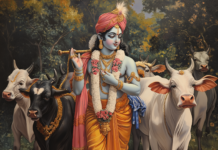The Bhagavad Gita, a revered scripture of ancient Indian wisdom, primarily focuses on philosophical and spiritual teachings rather than describing specific yoga poses. However, it does touch upon the essence of yoga practice and provides insights into the underlying principles. The Gita emphasizes the paths of selfless action (Karma Yoga), devotion (Bhakti Yoga), and knowledge (Jnana Yoga) as means to attain spiritual liberation. While it does not provide a detailed list of yoga poses, it does mention certain postures that can be inferred to have yogic significance. Let’s explore a few instances where postures are mentioned metaphorically in the Bhagavad Gita:
- Sthira-sukham asanam: In Chapter 2, Verse 46, Lord Krishna advises Arjuna, “Be steady in your posture, find comfort in it.” While this verse does not refer to a physical yoga pose, it symbolizes the need for mental and emotional stability, resilience, and balance in the face of challenges.
- Yogic symbolism: The Gita occasionally employs figurative language to convey deeper spiritual truths. For instance, in Chapter 6, Verse 13, Lord Krishna describes the yogi’s practice of controlling the mind by comparing it to holding a steady flame in a windless place. This metaphor suggests the importance of mental focus and concentration, similar to the way a flame remains unwavering in a still environment.
- Meditation posture: Although not explicitly mentioned in the Gita, the practice of meditation is alluded to. In Chapter 6, Verses 11-12, Lord Krishna describes the ideal conditions for meditation, including finding a clean and quiet place, sitting in a comfortable position, and directing the gaze towards the tip of the nose. While specific asanas are not named, this passage hints at the importance of maintaining a stable and relaxed posture during meditation.
It’s important to note that while the Bhagavad Gita doesn’t provide an extensive list of yoga poses, it conveys the essence and underlying principles of yoga, emphasizing the importance of mental focus, self-discipline, and spiritual awakening. The physical practice of yoga asanas, as we know them today, has evolved over time and is primarily described in other classical yoga texts, such as the Hatha Yoga Pradipika and the Yoga Sutras of Patanjali.




























